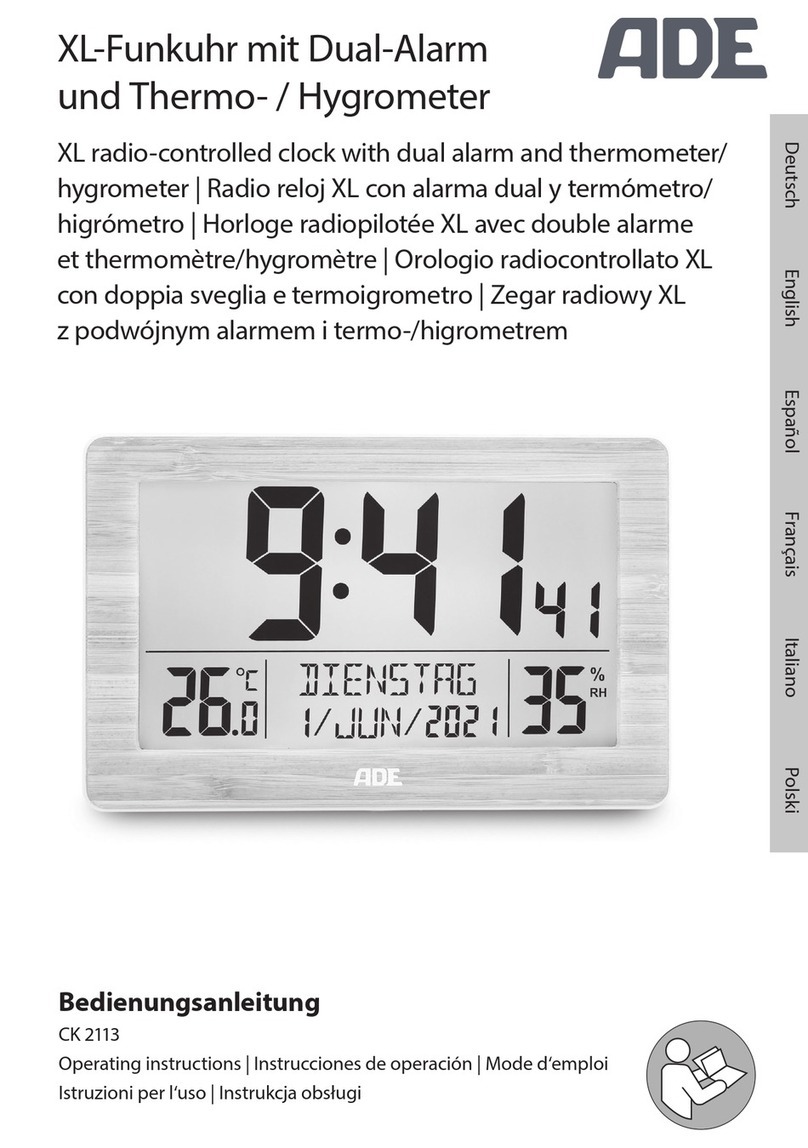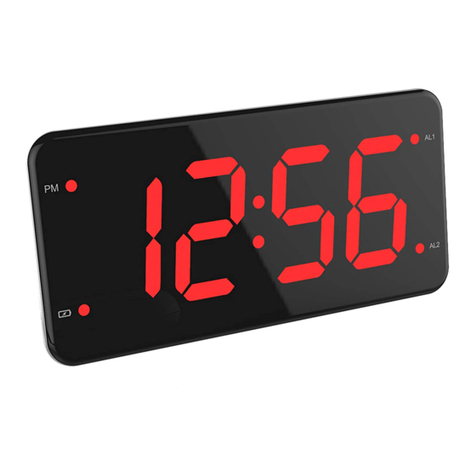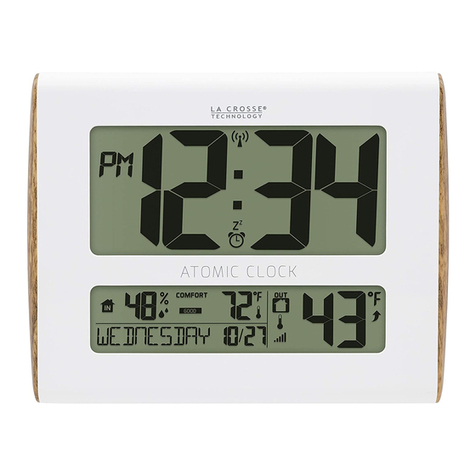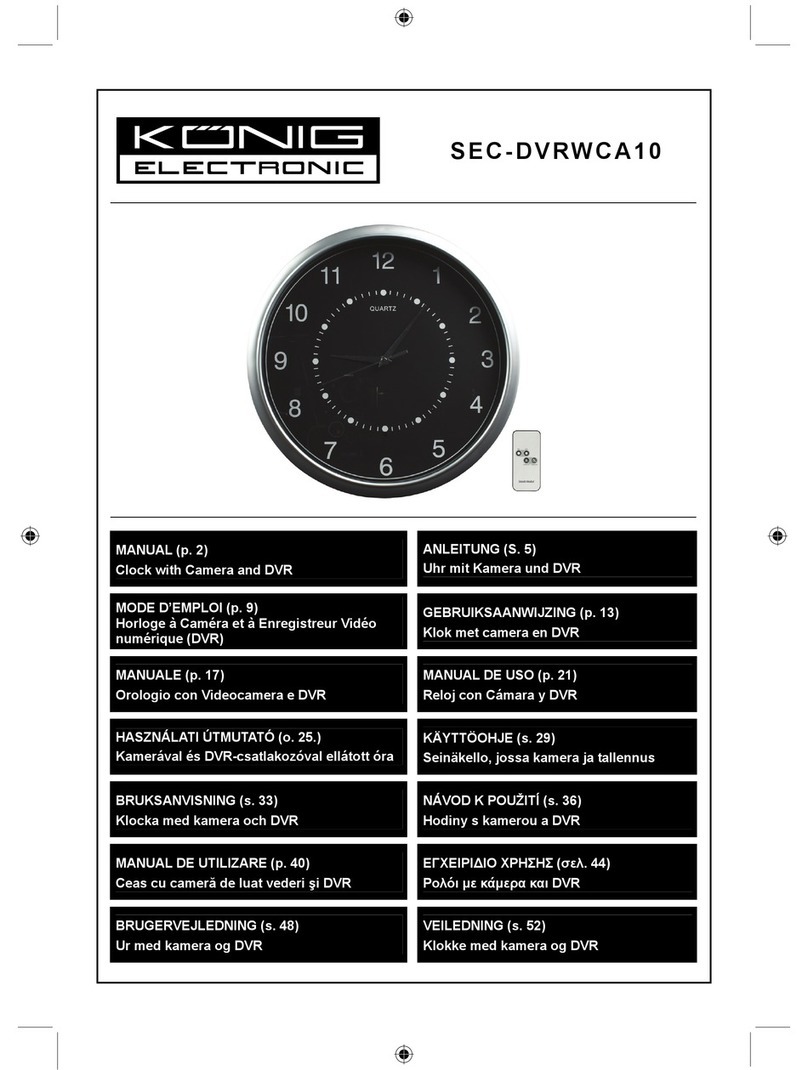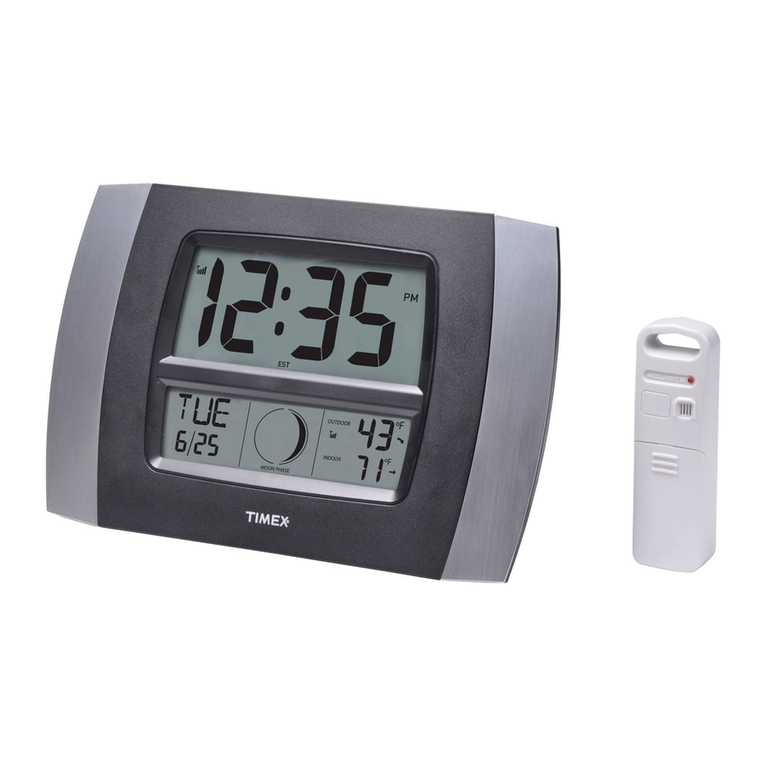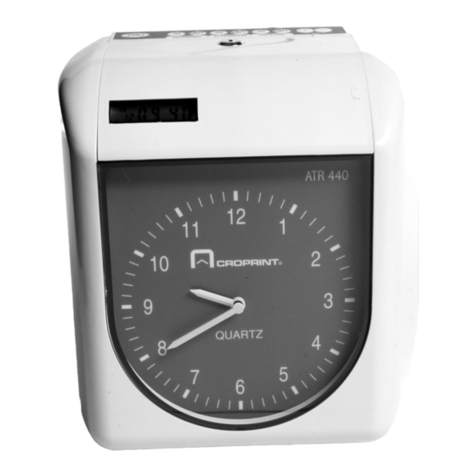THG TIM 2015 User manual

TIM 2015 Technical Manual v1 (February 2018) Page 1
TIM 2015 Speaking Clock
T CHNICAL MANUAL

TIM 2015 Technical Manual v1 (February 2018) Page 2
TIM 2015 is part
-
funded by the Telecommunications Heritage Group (THG and d
esigned by
WORK IN PROGR SS! A document of this kind is never entirely complete, so once the website is complete (www.TIM2015.uk) please
check for a newer version. Thank you for your understanding.
PL AS NOT : This is the
Technical Manual
. For setting up the clock after completion and information on the various methods of
synchronising the correct time please see the separate
User Manua
l document. The
Assembly Manual
explains how to construct TIM
2015.
Document doesn’t print properly?
All TIM 2015 documentation is produced in the DIN A4 format (8.2 " x 11.69"), which may cause problems when printing onto US Letter
size (8.5" x 11") paper. With Acrobat Reader for instance under Size Options, you will see four options: Fit, Actual size, Shrink oversized
pages and Custom Scale. One of these should work; we would suggest Shrink oversized pages, which will normally reduce the scale by a
few per cent and will not be very noticeable.
How to use this manual
This manual is written in something close to plain English and should be easy to follow (if not, tell us!). Yes, there’s a lot of it but you don’t
have to read it all in one session. The text is as comprehensive as possible, simply because not every constructor will be familiar with some
of the tasks.
Important information is printed in bold type like this.
Supplementary information that it is not essential to read the first time around, but could well be of value at a later stage, is printed in
panels (box-outs) with a grey background.

TIM 2015 Technical Manual v1 (February 2018) Page 3
The manual is arranged in numbered Chapters. The contents page follows.
And yes, there are a lot of words to read, simply because we tried to make the assembly process impossible to get wrong. Take it in stages if
you prefer.
Finally, if you get stuck, do try reading the manual a second time, perhaps more slowly. Things often become simpler to understand after
several readings. For a valuable and independent guide to using TIM 2015 please visit
http://www.samhallas.co.uk/repository/tim_2015.htm. Sam Hallas describes there how he built his own TIM 2015. It’s well worth reading!
User feedback
We welcome this! So if you have spotted a mistake in this manual, something you disagree with or else something you think could be
clarified, please get in touch. The same applies for anything you feel has been left out. Maybe you wish to comment on the product itself or
perhaps would like to suggest an improvement. Get in touch by an e-mail to andrew_emmerson@btinternet.com . We’ll respond as soon as
humanly possible (but please bear in mind this is a spare-time activity).
Clarification
Here are three things that we need to stress in order to avoid any confusion.
Accuracy. The claim that we make for TIM 2015 is that it is accurate to within a second but no more. In other words, if you synchronise
TIM 2015 to a source of GPS signal or to a radio time signal transmitter such as MSF, DCF or WWVB, it is of ‘indicative’ but not ‘absolute’
accuracy, making it adequate for all everyday purposes.
Authenticity. The voice files used in TIM 2015 are all taken from recordings of actual speaking clocks, taken from a variety of sources. In
some cases the recordings were taken directly from the speaking clock apparatus with the agreement and kind cooperation of the museum
authorities involved. In other cases they were made from Internet files or tape recordings made in the past, processed for greater clarity as
necessary. The method in which the words, phrases and sounds are played out from digital media means the timing of the words may vary
very slightly from the timing of the original announcements but only by fractions of seconds and not in a way that users would detect.
Intellectual property. It is our understanding that all recordings used in TIM 2015 are in the public domain. They are provided in good faith
for non-commercial use, with no charge made to the end user other than the media on which they are recorded.

TIM 2015 Technical Manual v1 (February 2018) Page 4
Acknowledgments
Thanks to Dave Thorpe for his superb circuit design work, also to Mick Champion, Alan David, Mike Fletcher, Sam Hallas, Howard Harte,
John Nice, John Novack, Jayson Smith, Evan Stewart and Dave Whistler for their material assistance and inspiration. Photographs by Dave
Thorpe, Sam Hallas, David Henderson, Andrew Emmerson and the manufacturers and suppliers of various parts used. The computer-
engraved panels are produced for us by Architectural & Industrial Engravers, Northampton (http://www.aiengravers.co.uk/).
We suggest you print a hard copy of this document and keep it in a ring binder or one of those plastic display book folders
that you can buy at pound shops and in many supermarkets.
The latest version of this manual will be available to download at www.TIM2015.uk as soon as the website has been
created.
TIM 2015 IS DESIGNED
AND MADE IN BRITAIN

TIM 2015 Technical Manual v1 (February 2018) Page 5
Index to the sections of this manual
1. Technical description of TIM 2015
2. Diagnostic messages
3. Troubleshooting (problem solving)
4. Background information
5. Upgrades
6. The Catalex serial MP3 player
. Creating new ‘voices’ for TIM 2015
8. Revisions to this manual
9. Safety notice and legal disclaimer
Each section begins on a fresh page.
Please note that this is the Technical Manual. There is also a separate User Manual and also an Assembly Manual.

TIM 2015 Technical Manual v1 (February 2018) Page 6
Chapter 1 Technical description
People can use TIM 2015 very happily without reading anything in this manual! The information in this section is provided for people who
like to look ‘under the bonnet’ (British English) or ‘under the hood’ (US English) of TIM 2015.
How TIM 2015 works
The clock is controlled by a Microchip PIC18F25K22 microcontroller running encrypted assembler code at a clock speed of 32MHz from its
internal oscillator.
Timekeeping is provided by a Maxim DS3231 RTC (Real Time Clock) chip (fitted to module MOD3.) This chip has an integrated
temperature-compensated crystal oscillator (TCXO) and 32 68 kHz crystal for timekeeping accuracy of ±2ppm (or better) from 0°C to
+40°C. A long-life CR2032 lithium 3V coin cell maintains timekeeping during power failure.
The DS3231 communicates with the microcontroller using a serial I
2
C Interface and also provides a 1-second pulse to synchronise the voice
and time display updates (module MOD3 also contains a separate memory chip, which is not used).
The time of day speech announcements are handled by the Catalex player module (MOD4). This contains a dedicated YX5300 stereo audio
processor chip usually used for MP3 players. It also plays the WAV files used for the voice announcements in TIM 2015. The device
supports audio sampling frequencies of 8, 11.025, 12, 16, 22.05, 24, 32, 44.1 and 48 kHz.
Only one audio channel is being used for the mono recordings employed in TIM 2015. The microcontroller controls the Catalex player using
command strings sent at 9600 baud.
Voice files are stored as .WAV files (or .MP3 files) in folders on a microSD card. For each time-of-day announcement the microcontroller
compiles a list of required files and commands the Catalex module to play each file in sequence. The module reports when each file has
been played, ready for the microcontroller to request the next one.
The audio output from the Catalex player is filtered by an op-amp, IC3B (MC330 2), to reduce frequencies higher than 3,300Hz, as they lie
above the range of frequencies used for telephony.

TIM 2015 Technical Manual v1 (February 2018) Page 7
The audio is then passed to module MOD5 (Mitel 88422-3), which connects it to a telephone line (in the same way as a telephone answering
machine answers a call). This module a specialised telephone line interface to handle the transmission of audio, call ringing detection and
line seize/release. It isolates the phone line voltage and provides logic-level control lines for the microcontroller to detect incoming calls
(ringing) and answer/release them.
The audio announcements are also sent via a volume control (R26) to an audio power amplifier module (MOD6). This contains a PAM8403
stereo 3-watt Class D amplifier IC that lets you hear the announcements on a loudspeaker for quality monitoring and testing. This PAM8403
chip uses digital audio processing to achieve an efficiency of up to 90%, resulting in much reduced power consumption. Only one audio
channel of the amplifier is used because the sound in TIM 2015 is mono (not stereo).
The volume control also incorporates a switch output, which is inverted by transistor T5 to place the PAM8403 chip into very low power
shutdown mode (consuming less than 1µA) when the (switched) volume control is turned off. A separate part (IC3A) of the MC330 2 op-
amp provides an audio output for headphones, monitoring, etc. and has its own volume preset (R20).
A 128x64-pixel, ST 920-type LCD module (QC12864B) is used for the graphic display screen. It uses a 3-wire serial SPI interface to
communicate with the microcontroller. Display brightness is controlled using a PWM output from the microcontroller to driver transistor
T3.
The user interface is provided by a mechanical rotary encoder (with switch). When it is turned between each detent it sends a series of logic
level pulses via the two wires (A and B). By analysing the phase of these pulse edges the microcontroller determines the turn direction.
Power for the whole clock is provided by the 3-amp regulator module MOD1. This module contains an MP1584 switching regulator chip
running at around 1MHz for about 85% power efficiency with a 12V input. The high switching frequency should also reduce any EMI
interference that might otherwise degrade reception of radio time signal signals.
Transistor T4 periodically provides power to a small 3.3V regulator (IC1) under the control of the microcontroller. This 3.3V supply is
needed for the Wi-Fi module (MOD2) or can alternatively be used by an externally connected GPS module.
The Wi Fi module (MOD2) contains an ESP8266 processor that runs a program for handling the initial Wi-Fi configuration and then
periodically requesting the time from network servers. This Wi-Fi module uses a significant amount of power when active (about 200mA)
and although there is a low-power Sleep option, the module does not have the necessary Sleep pin connected to the header. This is resolved
by using transistor T4 to completely cut the 3.3V power when the module is not being used.
Communication is handled by a serial 3.3V logic link to the microcontroller. The module is not 5V-tolerant, requiring resistors R1 and R18
to lower the microcontroller output 5V logic levels to prevent damage to the Wi-Fi chip. Optional 30-second and serial time data outputs are

TIM 2015 Technical Manual v1 (February 2018) Page 8
provided. These are buffered by general-purpose transistors T1 and T2. A separate external interface and power supply will be needed if you
want to use these outputs for your own projects such as driving mechanical slave clocks or synchronising other devices.
Specifications
Power supply requirements:
9 - 12 Volts DC @ 1Amp rating (Switching type adapter preferred)
3 Volts lithium coin cell (CR2032) for the RTC timekeeping battery backup.
Power consumption:
Approx 0.55W (Amplifier=off, Wi-Fi=off, Display brightness setting=34 (half-power).
Approx 0. W (Amplifier=off, Wi-Fi=off, Display brightness setting=maximum brightness.
Approx 1.14W (Amplifier=off, Wi-Fi=active, Display brightness setting=maximum brightness.
Approx 2.35W (Amplifier=full volume (8Ω speaker), Wi-Fi=active, Display brightness setting=maximum brightness.
Backup timekeeping battery power consumption:
0.85µA (Estimated run-time >10 years (or the shelf life of the CR2032 battery)).
Dimensions:
PCB alone 140mm x 85mm x 1.6mm
Timekeeping accuracy:
Unadjusted RTC accuracy ±2ppm from 0°C to +40°C (about ± 5.4 seconds per month).
Timekeeping may be improved by timekeeping fine adjustment menu setting.
Crystal ageing:
First year: ±1ppm
1-10 Years: ±5ppm (RTC manufacturer’s estimate).

TIM 2015 Technical Manual v1 (February 2018) Page 9
Board dimensions (140 x 85mm)

TIM 2015 Technical Manual v1 (February 2018) Page 10
Board layout

TIM 2015 Technical Manual v1 (February 2018) Page 11
Circuit diagram

TIM 2015 Technical Manual v1 (February 2018) Page 12
Obsolescence warning — and reassurance
A crucial component used in TIM 2015 is the MH 88422 3 integrated circuit manufactured first by Mitel and subsequently by Zarlink. This
handles the interface between an analogue telephone line and the electronics that play out the voice messages.
It was last made in the 1990s and supplies are now hard to find, particularly in one-off quantities. However, there is no equivalent product
nor anything even vaguely comparable produced currently, which is why we were forced to employ it again in TIM 2015. We have secured
supplies to make at least 0 speaking clocks but must warn do-it-yourself constructors to ensure that you have one of these devices before
starting work. Supplies will not last forever.
Recycling
At the end of its serviceable life, this product should not be treated as household or general waste. It should instead be handed over to the
applicable collection point for the recycling of electrical and electronic equipment, or returned to the supplier for disposal.
RoHS regulations conformity
Although the Restriction of the Use of Certain azardous Substances in Electrical and Electronic Equipment Regulations 2008 (‘the RoHS
Regulations’) precludes the use of lead-based solder in newly made electrical products, Annexe C to the official RoHS Guidance Notes
nevertheless permits “the use of lead-based solders to be used in IT and telecommunications network infrastructure equipment. This
exemption does not cover end-terminating products such as PCs or telephones.” TIM 2015 is intended for use as a network infrastructure
element and users are hereby informed that small quantities of tin-lead solder are used in the product. For this reason it is recommended
that TIM 2015 is not used where people unaware of the hazards of lead poisoning might gain access to it.
C status
Several of the more specialist components used in TIM 2015 are Chinese Exports.

TIM 2015 Technical Manual v1 (February 2018) Page 13
Chapter 2
Diagnostic messages
TIM 2015 performs various diagnostics at power-on. If a problem is detected one of the following seven messages should be displayed. The
parts mentioned that may require your attention are illustrated on the following page.
Please set Time
This indicates no valid time has been set and retained in the RTC module.
Set the time and if it is not retained after power-off, check whether the CR2032 coin-cell has become dislodged or requires
replacement.
Please set Date
This indicates no valid date has been set and retained in the RTC module.
Set the date and if it is not retained after power-off, check whether the CR2032 coin-cell has become dislodged or requires
replacement.
Error: 01 VoiceHW
The Catalex sound module is not responding.
Try powering off and on again. If the message persists, check the module’s connections and try reseating the microcontroller IC
in its socket.
Error: 02 SDCARD
The microSD card carrying the voice files is not inserted properly. Alternatively you might see this message if the microSD card becomes
corrupted (which is unlikely).
Try powering off and on again. If the message persists, re-seat the microSD card in its socket in the Catalex player. Try using
another microSD card or check the card for file corruption, etc. using a PC card reader.

TIM 2015 Technical Manual v1 (February 2018) Page 14
Error: 03 Folders
No file folders have been detected on the microSD card.
Try powering off and on again. If the message persists, check the card for file corruption etc. using a PC card reader (the card
must have between 1 and 16 folders containing voice files).
Error: 04 RTCchip
There has been an error communicating with the RTC module chip. This message may also be reported while the clock is running.
Try powering off and on again, or try removing the CR2032 coin-cell for a few minutes. A watchmaker or similar small
screwdriver will enable you to prize it out of the holder.
Try re-seating the microcontroller IC in its socket.
Error: 05 RTCdata
There has been an error with the RTC time or date (this message may also be reported while the clock is running, with all four LEDs flashing).
This fault occurs occasionally when your radio time signal receiver sends non-compliant code (in other words, reports an ‘impossible’ time
of day like 25 o’clock) to TIM 2015 and confuses it entirely. This can occur if local radio interference (such as a noisy thermostat or an
unsuppressed passing motorcycle) is stronger than the signal from the distant radio time signal transmitter and corrupts the radio signal
received.
The solution is to power down, unscrew the case and remove the CR2032 coin-cell for a couple of minutes. Use a screwdriver to pop it out.
This will erase the stored time data and force the realtime clock (RTC) to reset.
If this does not do the trick, you need to force TIM 2015 back to its original state by doing a Factory Reset. Power down the clock, press
down the left-hand selector knob and hold it in while reconnecting power until the following message is displayed: Factory Reset? Yes
>No. Turn the knob to move the pointer to Yes and press the button. The reset is confirmed by Done and the clock will restart and prompt
for the time to be set. A factory reset may be required if the clock behaves abnormally or you want to easily reset the user settings back to
defaults. (The reset does not change any network configuration stored in the Wi-Fi module, if fitted.)
To gain access to the interior of TIM 2015, turn off the power and then loosen the four screws in the base of the plastic case and remove the
upper part of the case.

TIM 2015 Technical Manual v1 (February 2018) Page 15
Catalex player (blue module)
Micro SD card
(
projecting slightly
).
Side
with lettering uppermost
C
oin cell in its holder
(
with
e
ngraved lettering
visible and uppermost)
Microcontroller chip (the longest
chip on the board)

TIM 2015 Technical Manual v1 (February 2018) Page 16
Chapter
3
Troubleshoot
in
g
This chapter is in two halves. The first Chapter lists faults that may occur during construction and prevent you from getting TIM 2015 to
work at all, whilst the second section covers things that may come to light once you start using the completed clock.
The companion User Manual lists other problems that may crop up during use of TIM 2015.
Note that problems are frequently caused by unsoldered or badly soldered joints on the track side (underside) of the PCB. Visual
examination with a magnifying glass in bright light is the way to go. These words on good soldering are adapted from Wikipedia has these
wise words.
The most common defect when hand-soldering results from applying the solder before the parts being joined are heated enough. If
their temperature is not higher than the solder’s melting point, the result will be a cold solder joint. This is usually the result of the
soldering iron being used to heat the solder directly, rather than the parts themselves. Properly done, the iron heats the parts to be
connected, which in turn melt the solder, guaranteeing adequate heat in the joined parts for thorough wetting by the flux embedded
in the solder.
Therefore, heating the solder first may cause the flux to evaporate before it cleans the surfaces being soldered. A cold-soldered joint
may not conduct at all, have high resistance or may conduct only intermittently or noisily. Cold-soldered joints are a common cause
of equipment which passes testing, but malfunctions after sometimes years of operation.
A dry joint occurs when the cooling solder is moved, and often occurs because the joint moves when the soldering iron is removed
from the joint. Moving the part being soldered before the solder has cooled will cause a highly unreliable cracked joint. A dry joint
has a characteristically dull or grainy appearance immediately after the joint is made, rather than being smooth, bright and shiny.
This appearance is caused by crystallization of the liquid solder. A dry joint is weak mechanically and a poor conductor electrically.

TIM 2015 Technical Manual v1 (February 2018) Page 17
Graphic courtesy of Quora.com
In general a good looking soldered joint is a good joint. As mentioned, it should be smooth, bright, and shiny. If the joint has lumps
or balls of otherwise shiny solder the metal has not ‘wetted’ properly. Not being bright and shiny suggests a weak, dry joint.
Graphic courtesy of Instructables.com

TIM 2015 Technical Manual v1 (February 2018) Page 18
Graphics courtesy of Technologystudent.com
For all of these reasons it is essential to correct any cold or dry solder joints. If you find one, the solder on the joint should be
removed with solder-wick braid or a solder sucker and care taken to ensure that a good joint is made when re-soldering it.

TIM 2015 Technical Manual v1 (February 2018) Page 19
Assembly errors
1. Faulty connections in Molex connectors
Excellent as these Molex connectors are, they can fail. The female contact feeler is retained in the connector shell by a tiny ‘tang’
engaging in a slot. If the tang has not engaged properly, the wire can work up in the shell and lose contact with the spike or post out of
the male header part of the connector. If pulling on the wire allows you to withdraw it from the shell, that’s where your problem lies.
Resolve the problem by bending out the tang and checking that the wire is now properly restrained.
2. Missing lights
TIM 2015 performs a test of all four LEDs at switch-on and then illuminates them individually as appropriate. If any of them fails to
illuminate consider, first check whether the LED wired the wrong way round (negative light from a reverse-connected LED is invisible to
the human eye). Is the LED faulty? Try substituting another LED. Is plug not making proper contact on the matching connector on the
PCB? If this is not the problem check (and reflow if necessary) the appropriate soldered joints on the PCB.
3. Pressing the left hand control knob has no effect; in other words it does not take you into the Settings menu.
Solution 1: The pink wire from the encoder switch is not connected to the Encoder Molex connector. This may be due to a poor solder
joint on the encoder switch itself or a loose contact on the Molex connector. See Problem no. 1 above.
Solution 2: The wire connections to the encoder switch are incorrect. On the left-hand side the blue wire should be uppermost, with the
pink wire below. The right-hand side should have the brown wire on top, the mauve wire on the central solder tag and the yellow wire
at the bottom.
4. There is a discernible delay before audio is heard when switching on TIM 2015.
This is intentional. There is no audio output until the pips or toneburst is sounded for the first time. As you may switch on TIM 2015 at
any random moment a delay of up to eight seconds may occur until the next pips or toneburst moment.

TIM 2015 Technical Manual v1 (February 2018) Page 20
5. The liquid crystal display does not illuminate.
This could be for one of six different reasons.
(1) The connectors at either ends of the connecting cable (flylead) between the PCB and the display are displaced or offset to the left or
right (yes it’s easily done). Check visually.
(2) Accidental solder splash bridging two or more pins of the plug at the display end of the cable.
(3) Wires of the flylead have been transposed (connected in the wrong order). See sketch in Chapter 4, Wiring.
(4) Loss of continuity in the flylead (probably a loose Molex connector; see first problem in this section). Check with your multimeter
using the Resistance mode or even better the Resistance–with-audio-tone made if available.
(5) The plug at the display end of the cable has been pushed onto the pin header of the display the wrong way round. See sketch in
Chapter 4, Wiring. The body of the plug lies back over (covering) the PCB; it does not project over the edge (outside) of the board.
(6) The serial connection has not been made on the underside of the PCB. Most displays have three gold-plated lands that enable the
display to operate in either parallel or serial mode. In the photo that follows these are labelled JP2, circled in red. Our display needs
to operate in serial mode, so we need to connect the central land to the land above it, marked S. Make sure the central and upper
lands are scrupulously clean, using the Garryflex pad mentioned early in this instructional. Then heat each land with a hot soldering
iron and touch it with fine solder to ‘tin’ the gold pad. Then bridge both pads with the tip of the soldering iron and add a tiny
amount of solder so that the two pads are linked. Make sure the link you make does not touch the P pad.
Table of contents
Popular Clock manuals by other brands
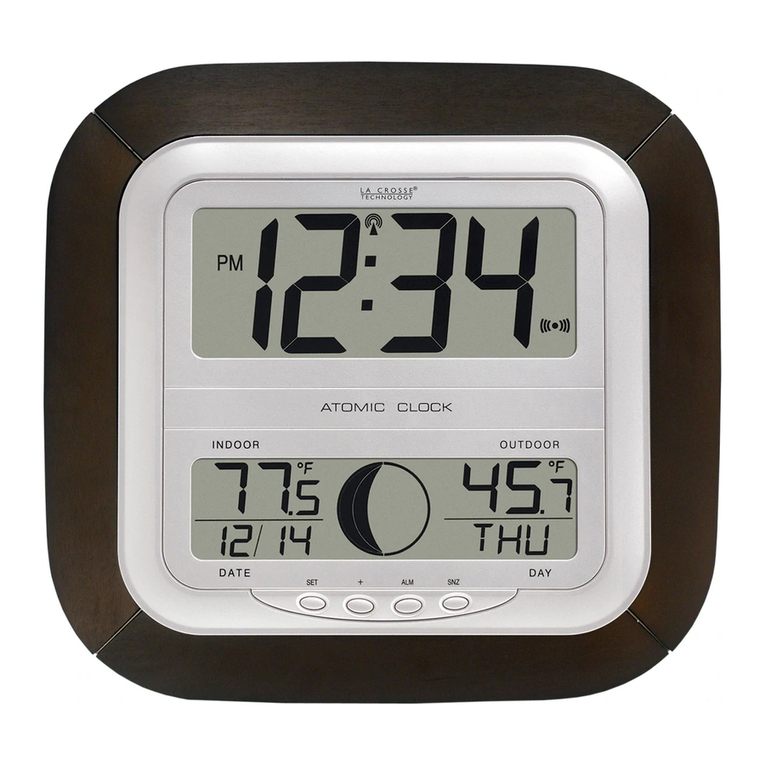
La Crosse Technology
La Crosse Technology WS-8418U-IT instruction manual
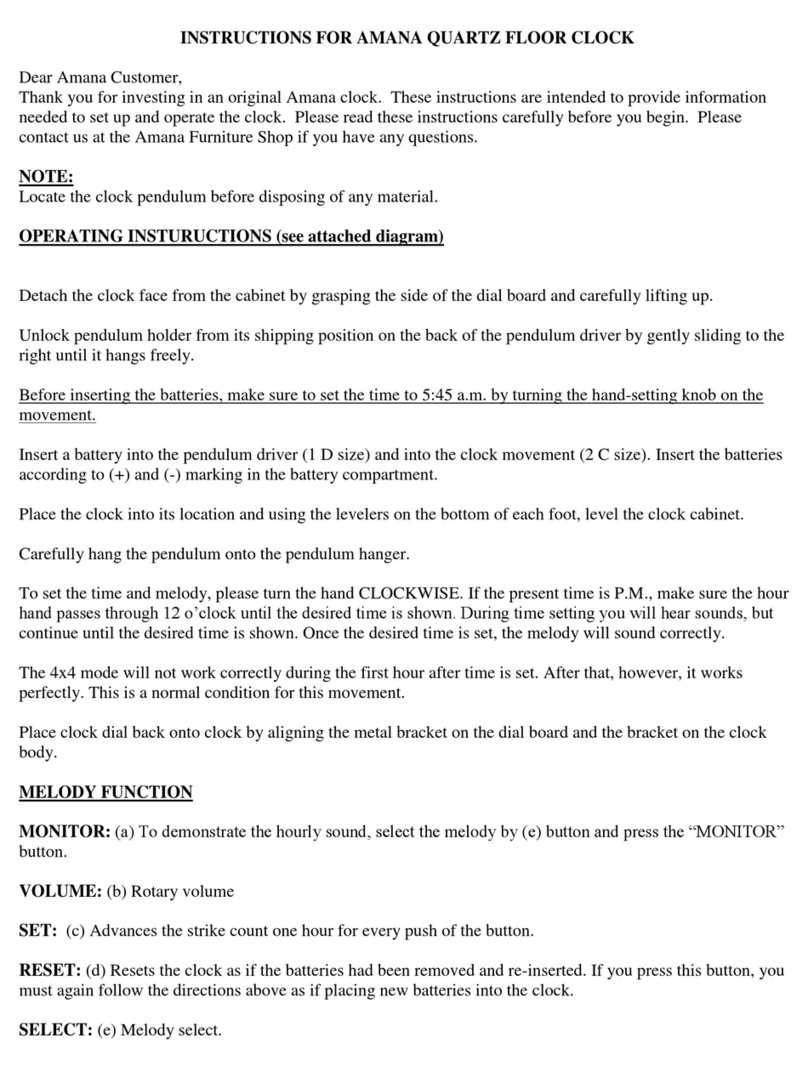
Amana
Amana APW-101 instructions
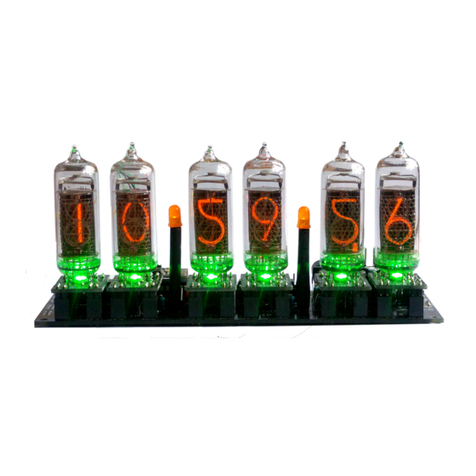
Nixie Clock
Nixie Clock IN-14 All-In-One Construction manual

Epson
Epson RX-8801SA/JE Applications manual
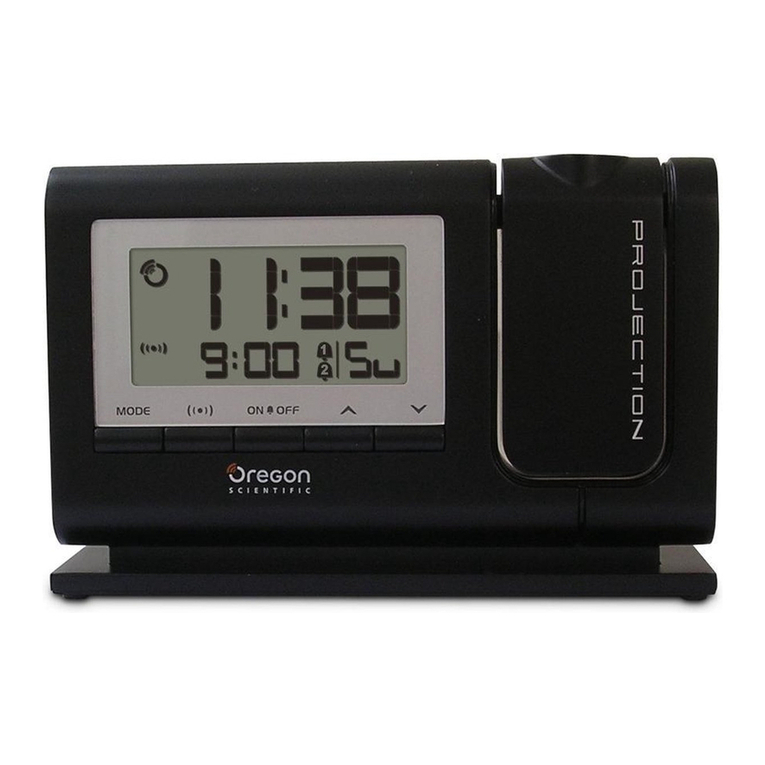
Oregon Scientific
Oregon Scientific RM308P user manual
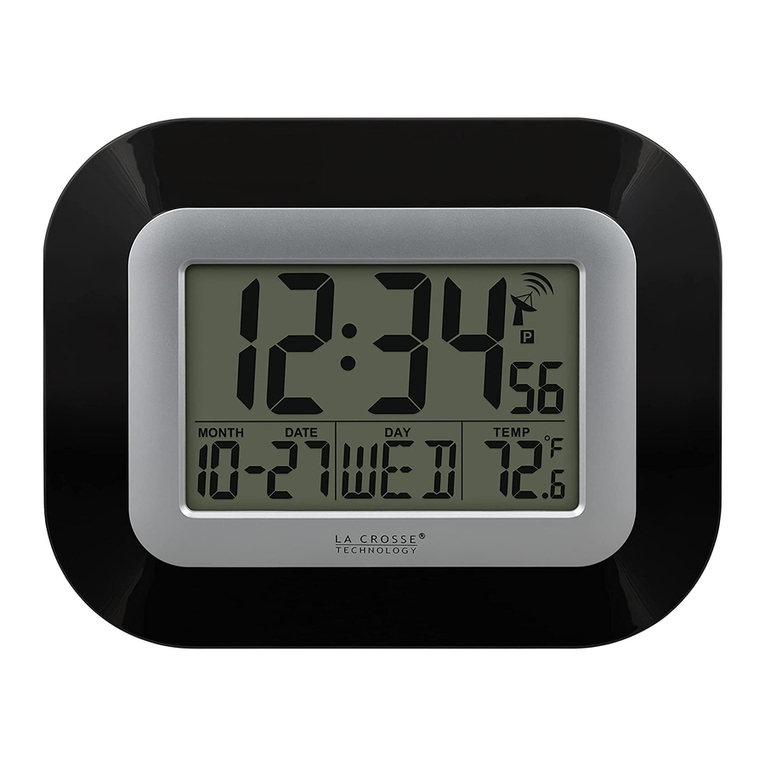
La Crosse Technology
La Crosse Technology WT-8005U manual
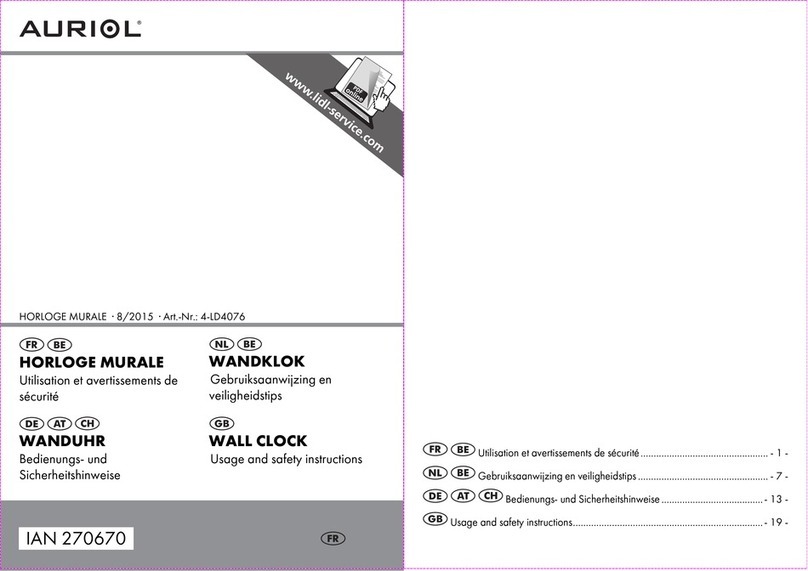
Auriol
Auriol 4-LD4076 Usage and safety instructions
Icon Time Systems
Icon Time Systems RTC-1000 2.0 quick start guide

Auriol
Auriol 303355 Operation and safety notes
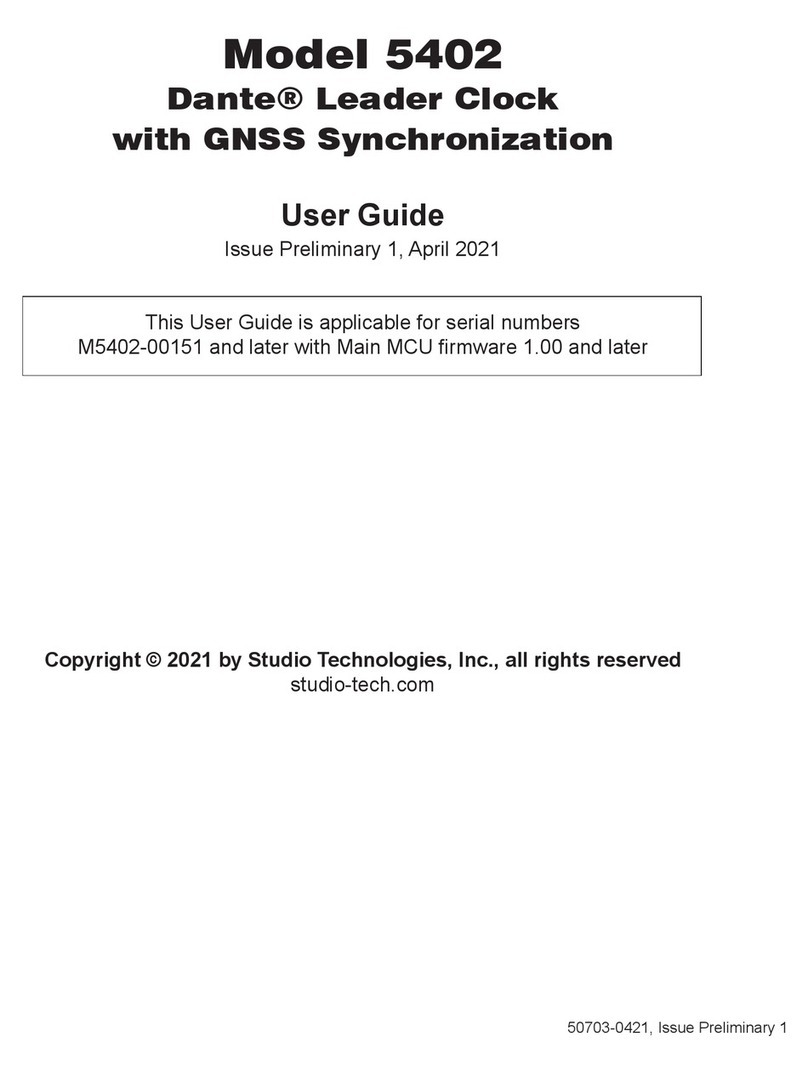
Studio Technologies
Studio Technologies 5402 user guide
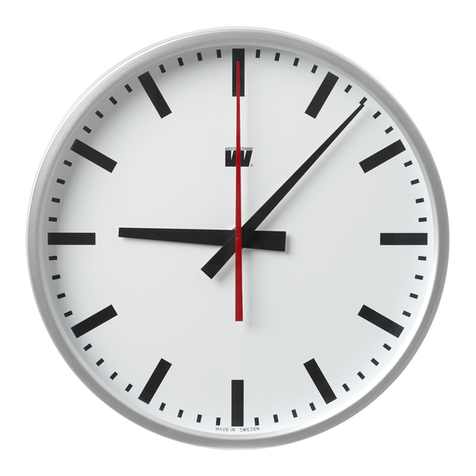
WESTERSTRAND
WESTERSTRAND Analogue NTP Clock manual
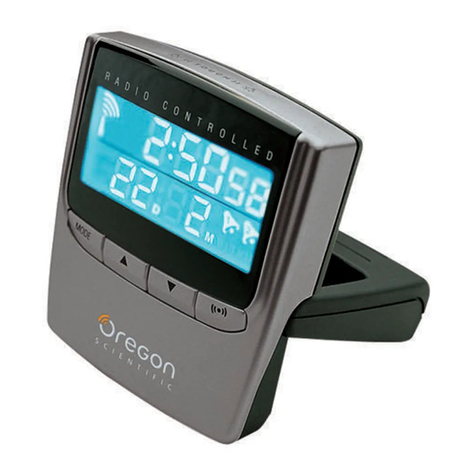
Oregon Scientific
Oregon Scientific RM822 instruction manual
